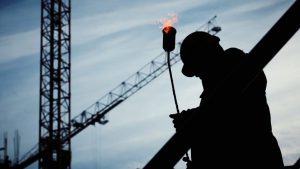A crane is one of the most important pieces of equipment on a construction site.
It only takes one error to cause a major tragedy.
Such is the reason why the Residential Construction Council of Ontario (RESCON), along with the Ontario Formwork Association (OFA) and partners recently came together to develop a best practices guide, the Construction Industry Code of Practice: Safe Use of Tower Cranes, which can be used by builders and trade contractors to erect, operate and dismantle tower cranes.
“We’re going to take all of the best practices that all the great members are doing out there and we’re going to put them in one document,” said RESCON VP Andrew Pariser, chair of the association’s safety committee.
“We’re going to come together with our partners in formwork and we’re going to see if we can even make improvements on what everybody is already doing.”
The free guide outlines what mechanical, electrical and structural inspections are required prior to erecting a tower crane on a building site, the methodologies and safe practices that should be followed when erecting the crane and what functional and operational tests are needed before it is put into operation.
“The idea is if you are a builder and you are going to build a project with a crane you can use this document to help you comply with the legislation, with the regs, with the CSA standards, with the manufacturing guidelines,” Pariser explained.
“It doesn’t replace anything, but it’s certainly a guide that focuses on implementation.”
The guide covers pre-erection inspections and reviews, initial erection on the project and safe operating practices, including climbing and dismantling procedures. It outlines what inspections must be done, documentation requirements and engineering inspections necessary at the pre-and post-erection stages, and what is required if multiple cranes are on a project.
There is a checklist of documents that must be retained at the project by the constructor and project management team.
In addition to RESCON and the formwork association, James Wilkinson, P.Eng. of Wilkinson Technical Services Inc., and RESCON’s crane safety committee and health and safety committee contributed to the document.
An important focus is the culture of safety and continuous improvement.
“You can always do more,” said Pariser. “In continuous improvement you set a goal, you work towards achieving that goal, you implement it and the next step is making an assessment of how successful you’ve been and setting a new goal. Continuous improvement means you’re never done and the work of safety is never done.”
Some elements included in the document are that the sectors exceeded minimum standards when it came to the various types of inspections, Pariser said.
“A lot of builders were already doing inspections more often whether it was NDT (non-destructive testing), some of the visual testing, some of the work that was being done before the crane is erected,” said Pariser. “The idea was you want to make sure that crane is as safe as possible before you put it up because obviously that is the easiest time to make changes.”
The process involved members and different companies sharing best practices with each other.
“It really was enshrining the best practices that are out there in the industry,” said Pariser. “One builder did one thing really well, another builder did another thing really well…It was very collegial and the idea was we need to do this for the betterment of the industry and when it comes to safety we’re all in it together.”
He added, “It was really that facilitation of safety experts and construction experts and engineers coming together and taking the time to codify the best practices and finding the gems at each company and getting them into one document.”
The guide will be distributed to all RESCON members and sent to the Infrastructure Health and Safety Association and Ministry of Labour, Immigration, Training and Skills Development. RESCON is also planning a crane safety event in January. The team is now focused on implementation and they anticipate doing another phase in the future.
“We want to get the message out, we want to get it implemented, we want members to start using it as quickly as possible but then we’re going to start looking at phase two,” Pariser said.
“We’ve got to broaden the net. We’ve got to bring in the people we weren’t able to bring in during phase one and we’ve really got to commit and stay committed to the continuous improvement model.”
Follow the author on Twitter @DCN_Angela











Recent Comments
comments for this post are closed